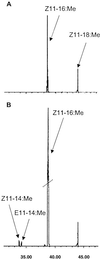Evolution of moth sex pheromones via ancestral genes
- PMID: 12237399
- PMCID: PMC129724
- DOI: 10.1073/pnas.152445399
Evolution of moth sex pheromones via ancestral genes
Abstract
Mate finding in most moth species involves long-distance signaling via female-emitted sex pheromones. There is a great diversity of pheromone structures used throughout the Lepidoptera, even among closely related species. The conundrum is how signal divergence has occurred. With strong normalizing selection pressure on blend composition and response preferences, it is improbable that shifts to pheromones of diverse structures occur through adaptive changes in small steps. Here, we present data supporting the hypothesis that a major shift in the pheromone of an Ostrinia species occurred by activation of a nonfunctional desaturase gene transcript present in the pheromone gland. We also demonstrate the existence of rare males that respond to the new pheromone blend. Their presence would allow for asymmetric tracking of male response to the new blend and, thus, evolution of an Ostrinia species with structurally different sex pheromone components.
Figures





Comment in
-
Mechanism for saltational shifts in pheromone communication systems.Proc Natl Acad Sci U S A. 2002 Oct 15;99(21):13368-70. doi: 10.1073/pnas.222539799. Epub 2002 Oct 8. Proc Natl Acad Sci U S A. 2002. PMID: 12374851 Free PMC article. Review. No abstract available.
References
-
- Paterson H E H. In: Species and Speciation. Vrba E S, editor. Pretoria, South Africa: Transvaal Museum; 1985. pp. 21–29.
-
- Phelan P L. In: Insect Pheromone Research. Cardé R T, Minks A K, editors. New York: Chapman & Hall; 1997. pp. 563–579.
-
- Phelan P L. In: Insect Chemical Ecology. Roitberg B D, Isman M B, editors. New York: Chapman & Hall; 1992. pp. 265–314.
-
- Löfstedt C. Philos Trans R Soc London B. 1993;240:167–177.
-
- Klun J A, Bierl-Leonhardt B A, Schwarz M, Litsinger L A, Barrion A T, Chiang H C, Zhungxie J. Life Sci. 1980;27:1603–1606. - PubMed
Publication types
MeSH terms
Substances
Associated data
- Actions
- Actions
- Actions
- Actions
- Actions
- Actions
- Actions
- Actions
LinkOut - more resources
Full Text Sources

